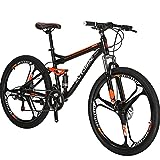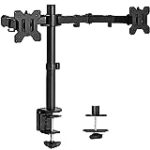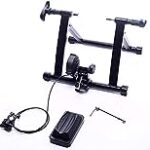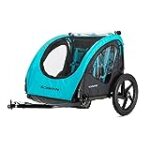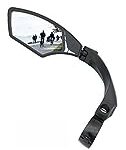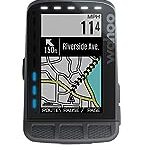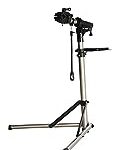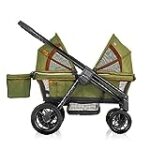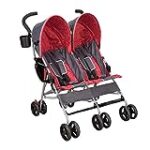🌅 Introduction
Welcome to our comprehensive buying guide for dual suspension mountain bikes. If you’re an avid mountain biker or a beginner looking to explore the thrilling world of off-road cycling, you’ve come to the right place. Dual suspension mountain bikes offer the perfect balance between comfort and performance, allowing you to conquer even the most challenging terrains with ease. In this guide, we’ll delve into the key factors to consider when purchasing a dual suspension mountain bike, including frame material, suspension system, components, and more. So, let’s dive in and find the perfect ride that will elevate your mountain biking experience to new heights.
🏆 Our Top 5
- 【High Tech Frame】High carbon steel soft tail frame has better strength, stability and toughness, which can better absorb vibration. Compared with aluminum frame, rider is not easy to feel fatigued during riding,enjoys the adventure on mountain roads, forest paths and highways.
- 【Full Suspension】Full suspension bike has better shock absorption, adapt to more terrainsgiving you a more comfortable ride on rough roads and provide a durable riding experience. In addition, soft tail ensures that the tires are fully gripped to maintain control on descents.
- 【Professional Drive Train】21 drivetrain is precise and simple to control, a wide range of gears gives you more control for climbing and room to get low on descents, corners and jumps. Disc brake of bicycle helps rider stop immediately in all conditions even in rainy.
- 【XC Sport Tires】26”XC tires are faster acceleration, easier handling, more responsive than bigger wheel. Ideal for dual suspension mtb. Double wall rim is not only stronger but also protects the inner tube. This bike is suitable for whether you are a beginner or professional rider.
- 【Assembly Guide & Warranty】The 18-inch frame fits riders from 5’5’’ to 6’1'' tall. It is 85% pre-assembled, easy to assemble, assembly tools included. It's backed by a limited lifetime warranty. If you have any questions, please do not hesitate to contact us.
- 【Sturdy Steel Frame】Crafted from 26x17 inch carbon steel frame with weight capacity of 250lbs, our mountain bike provides a safe and sturdy cycling experience. The 26 inch mountain bike is ergonomically designed for mens womens with heights ranging from 5'4"-6'2" (64-74 inches)
- 【21-Speed with Disc Brakes】Thumb shifter can ensure switching gears smoothly. When encountering different terrains, simple operation allows for quick selection of gears. Mechanical dual disc brake system, and simple structure are both convenient for maintenance.
- 【Front Fork + Shock Absorber】This all-terrain mountain bike(MTB) are equipped with shock-absorbing front and rear suspension. The dual shock absorbers work together to provide a double shock absorption effect, ensuring a smooth and comfortable ride. Additionally, the parallel bars are designed to adapt to various road conditions.
- 【26*2.125" All-Terrain Tires】Made of high quality rubber, all-terrain tires can soften the bumps and provide a stable ride. These tires offer strong puncture ressistance, making them suitable for various surfaces such as dirt, trails, gravel, and paved paths. With their excellent grip and non-skid function, slip is not a concern.
- 【85% Pre-Assembled】The bike comes 85% pre-assembled. You need to assemble the handlebar, saddle, front wheel and pedals. After a short adjustment of the brakes and gears you can start riding immediately. Please note that if you have any questions, you could contact our customer service first.
- 【Durable Steel Frame】24x15.5 inch sturdy and durable steel frame, provide safe and stable cycling experience. Ergonomically design, suitable for boys girls height 4'8"-5'3" (56-63 inches), max weight is up to 250lbs.
- 【21-Speed with Disc Brakes】Grip Shifter help to switch gears with smoothness. Simple operation allows for quick selection of gears for various terrains. Mechanical dual disc brake system, simple structure and convenient for maintenance.
- 【Front Fork+Shock Absorber】These all-terrain MTB feature shock-absorbing front and rear shock absorber. Dual shock absorbers provide double shock absorption effect, allowing you to ride smoothly and comfortably. The parallel bars can adapt to pressure road conditions.
- 【24*2.125" All-Terrain Tires】Made of high quality rubber, all-terrain tires with strong puncture ressistance soften the bumps and stick to the Dirt, Trail, Gravel, Paved Path for a smooth, stable ride: strong grip, have a super excellent anti-skid function and is not easy to slip.
- 【85% Pre-Assembled】The bike comes 85% pre-assembled. You need to assemble the handlebar, saddle, front wheel and pedals. After a short adjustment of the brakes and gears you can start riding immediately. Please note that if you have any questions, you could contact our customer service first.
- 【Durable Steel Frame】24x15.5 inch sturdy and durable steel frame, provide safe and stable cycling experience. Ergonomically design, suitable for boys girls height 4'8"-5'3" (56-63 inches), max weight is up to 220lbs.
- 【21-Speed with Disc Brakes】Twist Grip Shifter help to switch gears with smoothness. Simple operation allows for quick selection of gears for various terrains. Mechanical dual disc brake system, simple structure and convenient for maintenance.
- 【Front Fork+Shock Absorber】These all-terrain MTB feature shock-absorbing front and rear shock absorber. Dual shock absorbers provide double shock absorption effect, allowing you to ride smoothly and comfortably. The parallel bars can adapt to pressure road conditions.
- 【24*2.125" All-Terrain Tires】Made of high quality rubber, all-terrain tires with strong puncture ressistance soften the bumps and stick to the Dirt, Trail, Gravel, Paved Path for a smooth, stable ride: strong grip, have a super excellent anti-skid function and is not easy to slip.
- 【85% Pre-Assembled】The bike comes 85% pre-assembled. You need to assemble the handlebar, saddle, front wheel and pedals. After a short adjustment of the brakes and gears you can start riding immediately. Please note that if you have any questions, you could contact our customer service first.
- 【Durable Steel Frame】16 inch sturdy and durable steel frame, provide safe and stable cycling experience. Ergonomically design, suitable for mens womens height 4'2"-4'9"(50-57 inches).
- 【21-Speed with Disc Brakes】Grip Shifter help to switch gears with smoothness. Simple operation allows for quick selection of gears for various terrains. Mechanical dual disc brake system, simple structure and convenient for maintenance.
- 【Front Fork+Shock Absorber】These all-terrain MTB feature shock-absorbing front and rear shock absorber. Dual shock absorbers provide double shock absorption effect, allowing you to ride smoothly and comfortably. The parallel bars can adapt to pressure road conditions.
- 【24*2.125" All-Terrain Tires】Made of high quality rubber, all-terrain tires with strong puncture ressistance soften the bumps and stick to the Dirt, Trail, Gravel, Paved Path for a smooth, stable ride: strong grip, have a super excellent anti-skid function and is not easy to slip.
- 【85% Pre-Assembled】The bike comes 85% pre-assembled. You need to assemble the handlebar, saddle, front wheel and pedals. After a short adjustment of the brakes and gears you can start riding immediately. Please note that if you have any questions, you could contact our customer service first.
🤔 How to choose?
1. Frame Material: Choosing the Right Material for Your Dual Suspension Mountain Bike
When it comes to choosing a dual suspension mountain bike, one of the most important factors to consider is the frame material. The frame not only determines the durability and weight of the bike but also affects its performance on the trails.
There are several common frame materials used in mountain bikes, including aluminum, carbon fiber, and steel. Each material has its own unique characteristics and advantages.
**Aluminum** frames are lightweight, stiff, and affordable, making them a popular choice for many riders. They offer a good balance between strength and weight, making them suitable for both beginners and experienced riders.
**Carbon fiber** frames, on the other hand, are known for their exceptional strength-to-weight ratio. They are lighter than aluminum frames and provide a smoother ride due to their ability to absorb vibrations. However, carbon fiber frames tend to be more expensive.
**Steel** frames are known for their durability and ability to absorb shocks. They offer a comfortable ride and are often preferred by riders who prioritize comfort over weight. However, steel frames tend to be heavier than aluminum or carbon fiber frames.
2. Suspension Travel: Finding the Right Balance for Your Riding Style
Another crucial aspect to consider when choosing a dual suspension mountain bike is the suspension travel. Suspension travel refers to the distance the suspension can compress and extend, and it plays a significant role in determining how the bike handles different types of terrain.
The amount of suspension travel you need depends on your riding style and the type of trails you plan to tackle.
**Short-travel** bikes, typically with 100-120mm of suspension travel, are ideal for cross-country riding and smoother trails. They offer efficient pedaling and are lightweight, making them suitable for long climbs and endurance rides.
**Mid-travel** bikes, with 120-150mm of suspension travel, strike a balance between climbing efficiency and downhill performance. They are versatile and can handle a wide range of trails, making them a popular choice for most riders.
**Long-travel** bikes, with 150-180mm or more of suspension travel, are designed for aggressive downhill riding and technical trails. They excel in absorbing big hits and providing maximum control in challenging terrain. However, they may sacrifice some climbing efficiency due to their increased weight and suspension travel.
Finding the right suspension travel for your riding style is crucial to ensure a comfortable and enjoyable experience on the trails. Consider the type of terrain you’ll be riding on and the level of technicality you’re comfortable with.
3. Wheel Size: Choosing the Right Diameter for Your Dual Suspension Mountain Bike
The wheel size is another important consideration when choosing a dual suspension mountain bike. The most common wheel sizes for mountain bikes are 26-inch, 27.5-inch (also known as 650b), and 29-inch. Each wheel size has its own advantages and disadvantages, and the right choice depends on your riding preferences and the type of trails you’ll be tackling.
**26-inch** wheels were the standard for mountain bikes for many years. They offer quick acceleration, nimble handling, and are generally lighter than larger wheel sizes. However, they may not roll over obstacles as easily as larger wheels and can feel less stable at high speeds.
**27.5-inch** wheels strike a balance between the agility of 26-inch wheels and the stability of 29-inch wheels. They provide better traction and roll over obstacles more easily than 26-inch wheels, making them a popular choice for riders who want a versatile bike that can handle a variety of terrain.
**29-inch** wheels are known for their ability to roll over obstacles with ease and maintain momentum. They offer better stability and traction, especially on rough terrain. However, they may feel less maneuverable in tight corners and require more effort to accelerate.
Consider your riding style, the type of trails you’ll be riding on, and your personal preferences when choosing the right wheel size for your dual suspension mountain bike.
4. Components: Selecting the Right Groupset and Brakes for Your Riding Needs
The components of a dual suspension mountain bike, including the groupset and brakes, play a crucial role in its performance and reliability. Choosing the right components can greatly enhance your riding experience.
The **groupset** refers to the drivetrain components, such as the shifters, derailleurs, and crankset. It’s important to consider the number of gears, the quality of the components, and the brand reputation when selecting a groupset. Higher-end groupsets often offer smoother shifting, better durability, and lighter weight.
The **brakes** are another critical component to consider. Most mountain bikes come with either **rim brakes** or **disc brakes**. Rim brakes use pads that grip the rim of the wheel to slow down or stop the bike, while disc brakes use a rotor attached to the wheel hub and calipers to provide stopping power. Disc brakes offer better stopping power, especially in wet or muddy conditions, and are generally more reliable and easier to maintain.
Consider your riding style, the type of terrain you’ll be riding on, and your budget when selecting the components for your dual suspension mountain bike. Investing in high-quality components can greatly enhance your riding experience and ensure the longevity of your bike.
5. Fit and Geometry: Ensuring a Comfortable and Efficient Ride
Last but not least, the fit and geometry of the bike are crucial factors to consider when choosing a dual suspension mountain bike. A bike that fits you properly and has the right geometry can greatly enhance your comfort and efficiency on the trails.
The **frame size** is the most important aspect of fit. It’s essential to choose a frame size that matches your height and body proportions. A bike that is too small or too large can lead to discomfort and inefficient pedaling.
The **geometry** of the bike, including the angles and dimensions of the frame, also plays a significant role in how the bike handles and performs. For example, bikes with a steeper head tube angle tend to be more responsive and agile, while bikes with a slacker head tube angle provide better stability at high speeds and on steep descents.
Consider your body proportions, riding style, and preferences when choosing a dual suspension mountain bike. Test ride different models and sizes to find the one that feels the most comfortable and suits your riding needs.
By considering these factors – frame material, suspension travel, wheel size, components, and fit and geometry – you can make an informed decision when choosing a dual suspension mountain bike that will provide you with the best riding experience on the trails. Remember, it’s important to find the right balance between performance, comfort, and your budget to ensure a bike that will bring you joy for years to come.
💡 What to Look for in a dual suspension mountain bikes?
1. Frame Material: Finding the Perfect Balance
When it comes to dual suspension mountain bikes, the frame material plays a crucial role in determining the bike’s performance and durability. There are several options available, each with its own set of advantages and disadvantages.
One popular choice is aluminum, known for its lightweight nature and affordability. Aluminum frames offer excellent stiffness, allowing for efficient power transfer and responsive handling on the trails. They are also resistant to corrosion, making them a great option for riders who frequently encounter wet or muddy conditions.
On the other hand, carbon fiber frames have gained popularity in recent years due to their exceptional strength-to-weight ratio. Carbon frames are incredibly light, providing a nimble and agile ride. They also absorb vibrations better than aluminum, resulting in a smoother and more comfortable experience on rough terrain. However, they tend to be more expensive than their aluminum counterparts.
Ultimately, the choice of frame material depends on your budget, riding style, and personal preferences. If you prioritize lightweight and responsive handling, a carbon fiber frame might be the way to go. However, if you’re looking for a more budget-friendly option that still offers great performance, an aluminum frame could be the perfect fit.
2. Suspension System: Finding the Right Balance of Comfort and Control
The suspension system is another crucial aspect to consider when purchasing a dual suspension mountain bike. It plays a significant role in absorbing impacts from rough trails, providing a smoother and more controlled ride.
There are two main types of suspension systems to choose from: air and coil. Air suspension systems use compressed air to adjust the suspension’s stiffness, allowing riders to fine-tune their setup based on their weight and riding preferences. They are generally lighter and offer more adjustability, making them a popular choice among experienced riders.
On the other hand, coil suspension systems use metal coils to absorb impacts. They are known for their durability and ability to handle heavy loads, making them a great option for riders who engage in aggressive downhill riding or bikepacking adventures. While they may not offer as much adjustability as air suspension systems, they provide a plush and consistent feel on the trails.
When choosing a suspension system, it’s important to find the right balance between comfort and control. If you prioritize a plush and forgiving ride, a coil suspension system might be the way to go. However, if you prefer a more responsive and adjustable setup, an air suspension system would be a better fit.
3. Components: The Devil is in the Details
In addition to the frame material and suspension system, the components of a dual suspension mountain bike play a crucial role in its overall performance and reliability. From the drivetrain to the brakes, each component contributes to the bike’s functionality on the trails.
One key component to consider is the drivetrain, which consists of the gears and chain. A high-quality drivetrain will provide smooth and precise shifting, allowing you to tackle steep climbs and fast descents with ease. Look for reputable brands such as Shimano or SRAM, known for their reliable and durable drivetrain components.
Another important component is the brakes. Dual suspension mountain bikes typically come equipped with either hydraulic or mechanical disc brakes. Hydraulic disc brakes offer superior stopping power and modulation, making them a popular choice among riders who tackle technical and steep terrain. Mechanical disc brakes, on the other hand, are more affordable and easier to maintain.
When it comes to components, it’s important to find the right balance between performance and budget. Investing in high-quality drivetrain components and brakes will ensure a reliable and enjoyable riding experience.
In conclusion, when searching for the perfect dual suspension mountain bike, it’s essential to consider the frame material, suspension system, and components. Finding the right balance between weight, durability, comfort, and control will result in a bike that meets your specific needs and preferences. So, take your time, do your research, and get ready to hit the trails with confidence!
🔍 How we picked?
1. Understanding the Importance of Dual Suspension Mountain Bikes
When it comes to conquering rugged terrains and enjoying an exhilarating off-road experience, dual suspension mountain bikes are the way to go. These bikes are specifically designed to provide riders with enhanced control, comfort, and traction on uneven surfaces. Whether you’re a beginner or an experienced rider, investing in a dual suspension mountain bike can greatly enhance your riding experience.
2. Factors to Consider When Choosing a Dual Suspension Mountain Bike
Choosing the right dual suspension mountain bike can be a daunting task, considering the wide range of options available in the market. However, by considering a few key factors, you can make an informed decision that suits your riding style and preferences.
a. Frame Material: The frame material plays a crucial role in determining the overall weight, durability, and performance of the bike. Common frame materials include aluminum, carbon fiber, and steel. Aluminum frames are lightweight and affordable, while carbon fiber frames offer superior strength and vibration damping. Steel frames, on the other hand, provide a comfortable ride but can be heavier.
b. Suspension System: The suspension system is the heart of a dual suspension mountain bike, and it greatly affects the bike’s performance on rough terrains. There are two main types of suspension systems: air suspension and coil suspension. Air suspension offers adjustable settings and is lighter, making it ideal for riders who prioritize weight and fine-tuning. Coil suspension, on the other hand, provides a plush and consistent ride, making it suitable for riders who prioritize comfort and durability.
c. Wheel Size: The wheel size of a dual suspension mountain bike can significantly impact its handling and maneuverability. The most common wheel sizes for mountain bikes are 27.5 inches and 29 inches. Smaller wheel sizes offer better maneuverability and acceleration, while larger wheel sizes provide better traction and stability. Consider your riding style and the type of terrain you’ll be riding on to determine the ideal wheel size for your needs.
3. Our Selection Process
At [Company Name], we understand the importance of selecting the right dual suspension mountain bike that meets your specific needs and preferences. Our team of experts carefully researches and tests various models to provide you with unbiased and reliable recommendations. We consider factors such as frame material, suspension system, wheel size, and overall performance to ensure that our recommendations cater to a wide range of riders.
We also take into account customer reviews and feedback to gain insights into real-world experiences with the bikes. By combining our expertise with the experiences of fellow riders, we strive to provide you with the most comprehensive and accurate information to guide your purchasing decision.
In conclusion, choosing the right dual suspension mountain bike requires careful consideration of factors such as frame material, suspension system, and wheel size. By understanding the importance of these factors and relying on expert recommendations, you can find a bike that enhances your off-road adventures and provides you with the ultimate riding experience.
💬 Frequently asked questions about dual suspension mountain bikes
1. What is a dual suspension mountain bike?
A dual suspension mountain bike, also known as a full suspension mountain bike, is a type of bicycle that features both front and rear suspension systems. These suspension systems are designed to absorb shocks and bumps encountered while riding off-road, providing a smoother and more comfortable ride. The front suspension, typically located on the fork, absorbs impacts from the front wheel, while the rear suspension, located on the frame, absorbs impacts from the rear wheel.
2. Why should I choose a dual suspension mountain bike over a hardtail?
While hardtail mountain bikes have their advantages, such as being lighter and more efficient on smooth terrain, dual suspension mountain bikes offer several benefits that make them a popular choice among off-road enthusiasts. The rear suspension system on a dual suspension bike helps to improve traction and control, especially when riding over rough and technical terrain. It also helps to reduce fatigue and increase comfort, allowing you to ride longer and tackle more challenging trails.
3. Are dual suspension mountain bikes suitable for beginners?
Yes, dual suspension mountain bikes can be suitable for beginners, especially those who are looking to explore more technical trails or ride for extended periods. The added comfort and control provided by the suspension systems can help beginners build confidence and improve their skills. However, it’s important to note that dual suspension bikes tend to be more expensive than hardtail bikes, so beginners on a tight budget may want to consider their options carefully.
4. What should I consider when choosing a dual suspension mountain bike?
When choosing a dual suspension mountain bike, there are several factors to consider. Firstly, consider the type of terrain you’ll be riding on. If you’ll be tackling more aggressive trails, look for a bike with longer travel suspension and a sturdy frame. Secondly, consider your budget. Dual suspension bikes can range in price, so it’s important to find one that fits within your budget without compromising on quality. Lastly, consider the bike’s components, such as the drivetrain, brakes, and wheels, as these can greatly impact the bike’s performance and durability.
5. How do I maintain a dual suspension mountain bike?
Proper maintenance is crucial to keep your dual suspension mountain bike in optimal condition. Regularly clean and lubricate the suspension components to prevent dirt and grime from affecting their performance. Check the suspension sag and adjust it according to your weight and riding style. Additionally, inspect the frame for any cracks or damage, and ensure that all bolts and fasteners are tightened properly. If you’re unsure about maintenance procedures, it’s always a good idea to consult the bike’s manufacturer or take it to a professional bike shop for servicing.
In conclusion, dual suspension mountain bikes offer a range of benefits for riders of all skill levels. Whether you’re a beginner looking to explore more technical trails or an experienced rider seeking enhanced comfort and control, a dual suspension mountain bike can be a great investment. Consider your riding style, budget, and maintenance needs when choosing the right bike for you, and don’t hesitate to seek expert advice if needed. Happy trails!
Last update on 2024-07-26 / Affiliate links / Images from Amazon Product Advertising API
